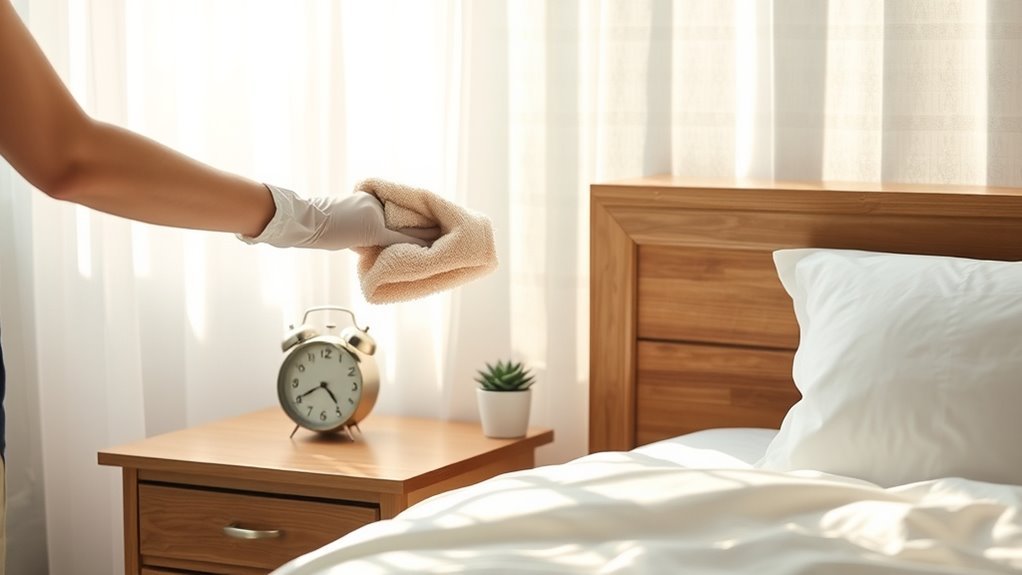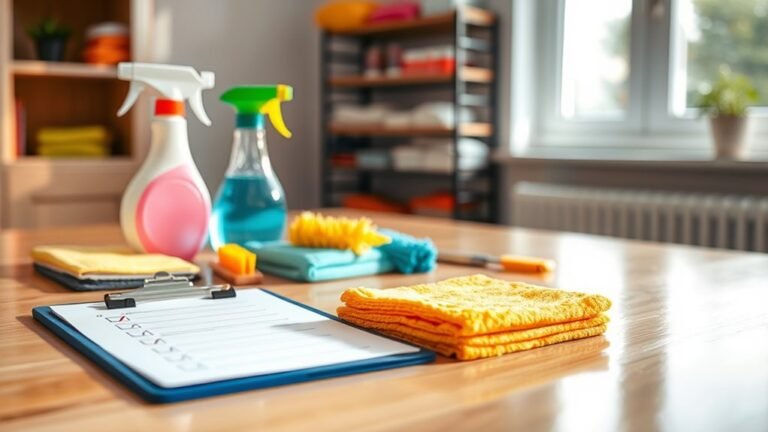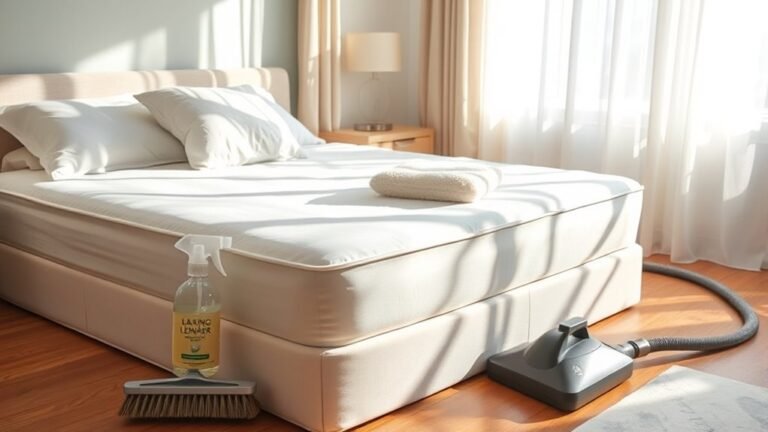Removing Dust Stains From Bedroom
To remove dust stains from your bedroom, start by identifying dust hotspots like open windows and cluttered surfaces. Use microfiber cloths and vacuum attachments for walls, ceilings, and furniture to trap dust without spreading it. Spot clean stains gently with mild soap solutions, and keep upholstery fresh by vacuuming and air drying. Decluttering and using an air purifier help maintain a dust-free space. Keep following along to discover detailed cleaning steps and prevention tips that make a big difference.
Identifying Common Sources of Dust Stains
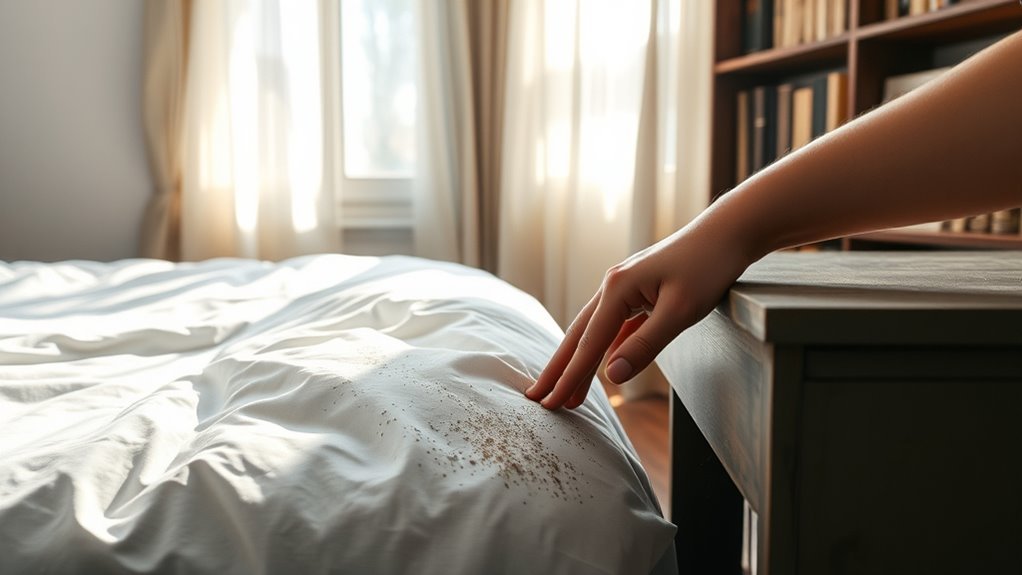
Before you can effectively remove dust stains from your bedroom, it’s important to identify where the dust is coming from. Dust accumulation usually starts from common sources like open windows, vents, and carpets where particles settle freely. You might not realize that cluttered surfaces and textiles, such as curtains and bedding, also trap dust, making it harder to keep your space clean. Understanding these sources gives you the freedom to target dust prevention more effectively. By pinpointing where dust gathers most, you’ll know exactly where to focus your efforts to stop it from building up again. Taking control over these origins means fewer dust stains and a fresher, more liberating environment where you can breathe easy and enjoy your bedroom fully.
Essential Tools and Cleaning Supplies Needed
Now that you know where dust tends to settle in your bedroom, gathering the right tools and cleaning supplies will make tackling those stubborn stains much easier. You’ll want a set of reliable cleaning tools designed for dust removal, like microfiber cloths that trap particles without spreading them around. A good duster with an extendable handle helps you reach high corners and ceilings effortlessly. Don’t forget a vacuum cleaner with a brush attachment to lift dust from walls and floors. For tougher spots, a gentle all-purpose cleaner or a mixture of water and vinegar works wonders without harsh chemicals. Having these dusting supplies ready gives you the freedom to clean efficiently and keep your personal space fresh and dust-free.
Step-by-Step Cleaning Process for Walls and Ceilings
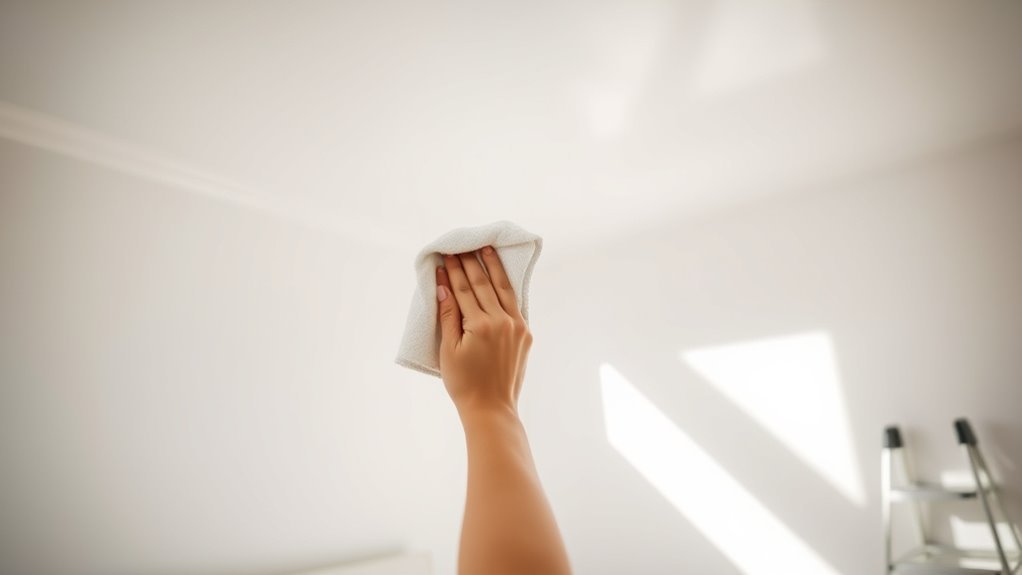
Although cleaning walls and ceilings might seem challenging, breaking the task into simple steps makes it manageable. You don’t have to feel stuck or overwhelmed when tackling ceiling cleaning and wall maintenance. Here’s how to get started:
- Dust first: Use a microfiber duster or vacuum with a brush attachment to remove loose dust from walls and ceilings.
- Spot clean: Mix mild soap with water, dip a sponge, and gently wipe any visible dust stains or marks.
- Dry and inspect: Let surfaces air dry, then check for any areas needing a second pass.
Effective Methods for Cleaning Furniture and Upholstery
Cleaning furniture and upholstery effectively requires the right tools and techniques to avoid damage while removing dust and stains. Start by using a soft microfiber cloth to gently wipe down your furniture, capturing dust without scratching surfaces. For wooden pieces, apply furniture polishing sparingly to restore shine and protect the finish. When tackling upholstery care, vacuum thoroughly with a brush attachment to loosen dust trapped in fabric fibers. For stains, spot clean with a mild detergent solution, testing in an inconspicuous area first to prevent discoloration. Avoid soaking fabrics, and allow them to air dry completely. By mastering these simple methods, you’ll keep your bedroom furniture looking fresh and inviting, freeing yourself from the hassle of stubborn dust stains.
Maintaining a Dust-Free Bedroom Environment

Since dust can accumulate quickly and affect your comfort and health, maintaining a dust-free bedroom environment is crucial. You want your space to feel open and fresh, free from allergens that weigh you down. Focusing on bedroom organization helps reduce dust traps and keeps surfaces easy to clean. Plus, investing in good air filtration guarantees cleaner air circulation, reducing airborne dust particles considerably.
Here’s how you can keep your bedroom dust-free:
- Declutter regularly to minimize dust-collecting items and improve airflow.
- Use a high-quality air purifier with HEPA filters to capture dust and allergens.
- Opt for smooth, easy-to-clean surfaces and store items in closed containers.
Frequently Asked Questions
Can Dust Stains Cause Allergies or Respiratory Issues?
Yes, dust stains can definitely cause allergies or respiratory issues. When dust collects, it often harbors dust mites, which are common triggers for allergy symptoms like sneezing, itchy eyes, and congestion. If you’re sensitive, these tiny creatures can make breathing uncomfortable and even worsen asthma. Keeping your space clean helps you stay free from those irritants, letting you enjoy fresh air without the hassle of allergy flare-ups.
How Often Should I Deep Clean to Prevent Dust Stains?
You should set a cleaning schedule that fits your lifestyle but aims for deep cleaning at least once a month to keep dust stains at bay. Regular dust prevention isn’t just about aesthetics—it helps you breathe easier and feel freer in your space. Combining weekly light cleaning with a monthly deep clean guarantees dust doesn’t build up, letting you enjoy a cleaner, more comfortable home without feeling tied down by chores.
Are There Natural Alternatives to Chemical Cleaning Products?
Seeking sustainable solutions? You can create eco-friendly solutions with simple, homemade cleaners like vinegar, baking soda, and lemon juice. These natural alternatives not only clean effectively but also free you from harsh chemicals and costly products. You’ll enjoy the freedom of customizing your cleaners to suit your needs, safeguarding your health and the planet. Plus, they’re easy to make and safe for your entire household.
Can Air Purifiers Reduce Dust Accumulation in Bedrooms?
You’ll find that air purifiers can definitely help improve air quality and boost dust control in your bedroom. By filtering out airborne particles, they reduce the amount of dust that settles on surfaces. This means you can enjoy cleaner, fresher air and less frequent cleaning. If you want more freedom from constant dusting, investing in a good air purifier is a smart move that supports a healthier, dust-reduced environment effortlessly.
What Fabrics Are Most Resistant to Dust Stains?
If you want fabrics that resist dust stains, silk fabrics are a great choice because their smooth texture makes dust less likely to cling. Cotton blends also work well since they combine durability with easier maintenance, helping you stay carefree about cleaning. Choosing these fabrics means less hassle and more freedom to enjoy your space without constantly worrying about dust buildup or stains, keeping your environment fresh and comfortable.
